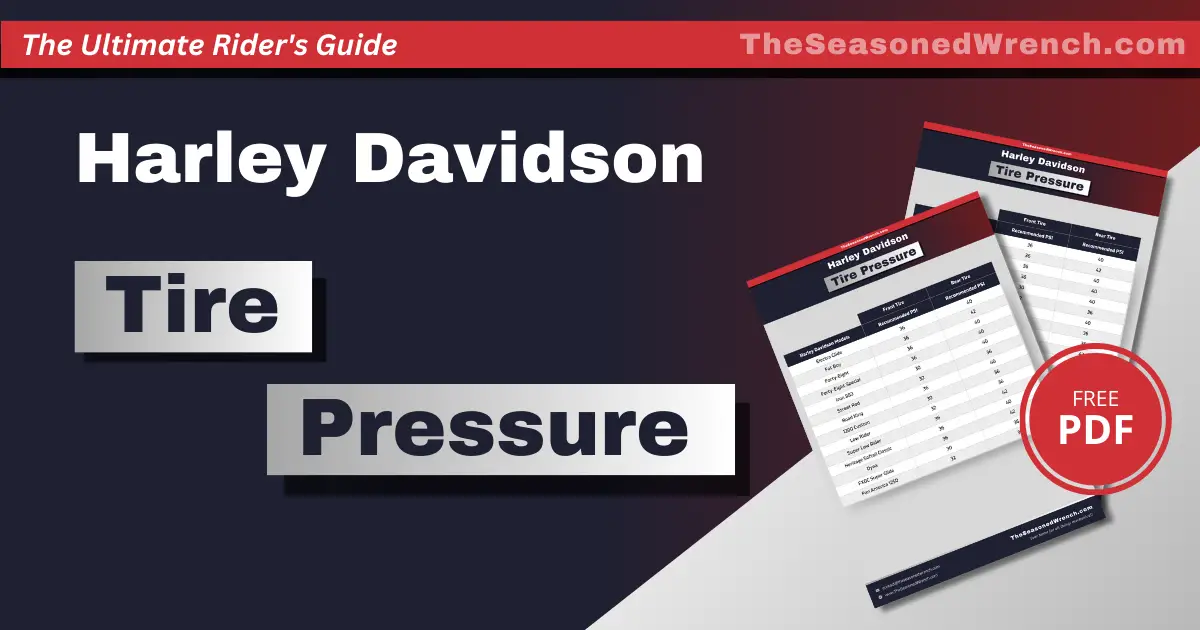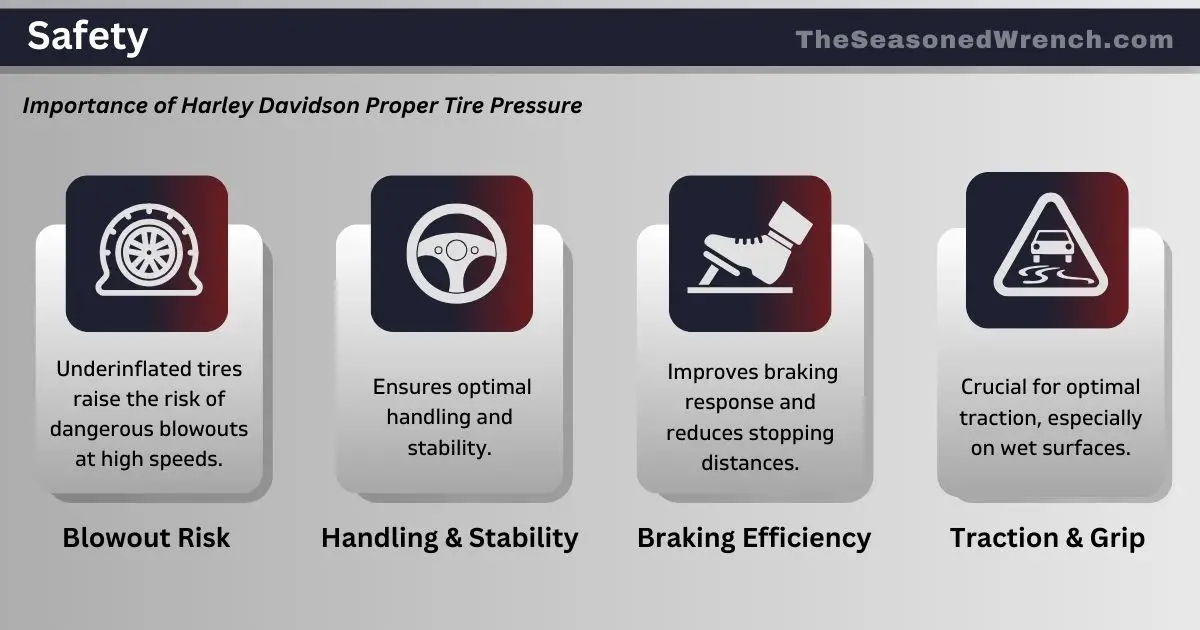
Maintaining the right tire pressure is important for any Harley rider. It’s not just about following maintenance routines; proper tire pressure greatly affects your motorcycle’s safety, performance, and overall riding experience.
This guide takes a detailed look at the importance of maintaining the correct Harley Davidson tire pressure, offering practical tips and insights for different riding conditions. From safety implications to performance benefits, we cover everything you need to know to keep your ride smooth and your tires in top condition. For your convenience, we’ve even included a detailed Harley Davidson tire pressure chart.
Let’s ride!
Related: Best Harley Touring Tires: Top Picks for Long-Distance Rides
Understanding the Importance of Harley Davidson Tire Pressure
Before getting to our Harley Davidson tire pressure chart, let’s first highlight the importance of tire pressure and its impact on your motorcycle’s handling, efficiency, and tire health.
Quick navigation:
– Harley Davidson Street Glide Tire Pressure: A Complete Guide
Safety

- Risk of Tire Blowouts: Incorrect tire pressure, especially underinflation, can lead to increased stress and heat buildup in the tires, significantly raising the risk of blowouts, which can be dangerous at high speeds.
- Handling and Stability: Proper tire pressure is crucial for optimal handling and stability. Overinflation can lead to reduced tire contact with the road, while underinflation can cause sluggish handling and increased rolling resistance.
- Braking Efficiency: The right tire pressure ensures that the maximum amount of tire surface is in contact with the road, providing better braking response and reduced stopping distances.
- Traction and Grip: Maintaining the recommended tire pressure is key for optimal traction. Both overinflation and underinflation can lead to reduced grip, affecting cornering and overall control, especially on wet or slippery surfaces.
Performance
- Fuel Efficiency: Properly inflated tires reduce rolling resistance, which means the engine doesn’t have to work as hard, leading to improved fuel efficiency.
- Ride Comfort: Correct tire pressure absorbs road irregularities better, ensuring a smoother and more comfortable ride.
- Motorcycle Longevity: Consistent and correct tire pressure helps in reducing wear on other motorcycle components, such as the suspension and brakes, contributing to the overall longevity of the motorcycle.
- Acceleration and Speed: Adequate tire pressure allows for better power transfer from the engine to the road, enhancing acceleration and maintaining optimal speed performance.
Tire Health

- Wear and Tear: Improper tire pressure can lead to uneven or accelerated tire wear. Overinflation causes wear primarily in the center of the tire, while underinflation results in wear on the edges.
- Tire Lifespan: Maintaining the correct tire pressure is essential for maximizing the lifespan of the tires, as it prevents premature wear and tear.
- Temperature Effects: Tire pressure can vary with temperature changes. It’s important to adjust the pressure with seasonal changes to maintain the right levels.
- Visual Inspections: Regular visual inspections can help identify issues like underinflation, overinflation, or tire damage, prompting timely maintenance or adjustments.
Learn more about Harley Davidson tires, including tire components, anatomy, types, sizing, and more in Harley’s Motorcycle Tires 101 guide.
What is the Correct Tire Pressure for a Harley Davidson?
Harleys are rated to hold anywhere from 30-36 PSI in the front tire and 36-42 PSI in the rear, depending on the model. To ensure your tire PSI is always where it should be, we’ve put together the below Harley Davidson tire pressure chart.
Harley Davidson Tire Pressure Chart
Adjusting Harley Tire PSI for Different Driving Conditions
As you saw in the above Harley Davidson tire pressure chart, Harley tires do have specific recommended PSI levels. However, it’s important to remember that these are based on optimal driving conditions. If you’re driving on the highway, in the mountains, or in especially hot weather, you’ll need to adjust your tire PSI accordingly.
Following what’s known as the “Rule of 2”, you can account for different conditions by changing your PSI by 2–here’s how:
- Highway Driving: When you’re hitting the highway, bump up your Harley rear tire pressure by 2 PSI and front by 2 PSI to help handle the higher speeds and load. Just be careful not to go over the maximum PSI recommended.
- Summer Driving: In the summer, tires can get hotter and their pressure can go up. To deal with this, drop your Harley front tire pressure by 2 PSI and rear by 2 PSI from your standard setting.
- Mountain Driving: Driving in the mountains or at high altitudes? Lower your Harley tire PSI by 2 PSI from the normal. This helps your tires grip those winding mountain roads better. As you climb or descend, your tire pressure can change, so keep an eye on it and adjust as needed.
How to Check Air Pressure for Harley Davidson Tires
Now that you understand recommended PSI levels and adjusting for conditions, let’s review how to check air pressure for Harley Davidson tires:
- Locate and Open the Valve: Start by finding the air cap valve on your tire. Carefully remove the cap to expose the valve.
- Use a Tire Pressure Gauge: Immediately press a tire pressure gauge onto the valve. This should be done swiftly to avoid losing too much air. You can choose between a traditional or a digital gauge, both are effective.
- Read the Pressure: Once the gauge is firmly in place, read the pressure level displayed on the gauge’s monitor.
- Compare with Recommended Pressure: Take the reading you’ve just obtained and compare it with the recommended tire pressure for your specific Harley model, as found in the pressure chart provided by Harley-Davidson.
- Adjust Tire Pressure: If the readings are off from the recommended pressure, adjust them accordingly. Inflate the tire if the pressure is too low, or deflate it slightly if it’s too high.
- Regular Maintenance: The entire process is quick and straightforward, usually taking no more than a couple of minutes. For optimal performance and safety, it’s recommended to check and adjust your tire pressure at least twice a month. Regular maintenance ensures your tires are always at the ideal pressure for your riding conditions.
TheSeasonedWrench: For All Your Motoring Needs
In conclusion, understanding and maintaining the correct tire pressure is key for the optimal performance and safety of your Harley Davidson. This comprehensive guide (and included Harley Davidson tire pressure chart) has covered everything from the basic importance of tire pressure to specific recommendations for various models and conditions. Regular checks and adjustments are key to ensuring a smooth and safe riding experience. While you’re here, I think it’ll be worth your while to check out my other technical resources:
– Harley Davidson Wiring Color Codes Completely Explained
– Unlock the Power of Harley Diagnostic Codes (PDF Included)
– Torque Specs for Harley Davidson: Ultimate Guide (PDF)
– Complete Harley Davidson Tire Size Chart (PDF)
– Harley Spark Plug Gap Chart: A Guide for Experienced Riders
With this knowledge, you’re now equipped to keep your Harley in top condition, ready for whatever the road brings. Safe travels and enjoy the ride!
